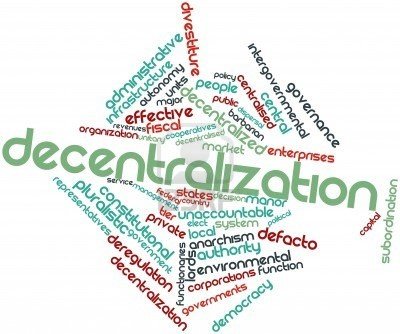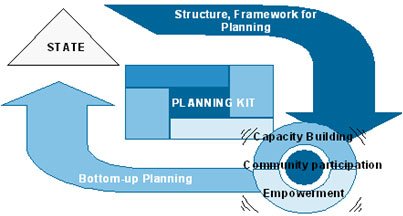Decentralised planning is a multi-level planning process where responsibilities of crafting and overseeing plans are shared across local and regional entities, away from a singular, centralized authority. This approach is celebrated for its cost-effectiveness, autonomy, grassroots focus, and reduction in bureaucratic red tape, all of which spur individual initiative. However, it can face challenges such as overlooking national priorities, resistance to change at lower levels, and the deficiency of technical expertise required for planning at the grassroots level. In this article, you will learn about definition and meaning of Decentralised Planning, Decentralised Planning in India and its advantages and disadvantages, all of which are very important topic for GS Paper-3 Economy of UPSC CSE Prelims and Mains Exam. To explore more interesting Economy UPSC topics of NCERT Class 10 and Class 12, check out other articles of IASToppers.
Table of Content
- What is Decentralised Planning?
- Decentralized Planning in India
- Merit of Decentralised Planning
- Demerits of Decentralized Planning
- Types of Decentralization
- Conclusion
- FAQs on Decentralized Planning
What is Decentralised Planning?
- Decentralisation of the planning process is an exercise in multi-level planning.
- In this, responsibilities of drafting, implementing, and overseeing plans are shared across local and regional bodies, moving away from a centralized authority.
- The approach of Decentralised Planning allows for democratic, locally-focused, and flexible planning processes.
Decentralized Planning in India
The concept of decentralized planning, or planning from the grassroots, is not new in India.
- First Plan (1951–1956): Since the inception of First Plan (1951–1956), the importance of decentralised planning was emphasised to achieve people’s participation in the planning process.
- The Balwant Rai Mehta committee (1957) recommended statutory elective local bodies with an area approach to decentralised planning in India.
- Second Plan (1956–1961) and Third Plan (1961–1966): Both Plans proposed localized plans and shifting responsibilities to local governance bodies, but these suggestions didn’t fully materialize.
- Fourth Plan (1969–1974): With the Fourth Plan, there was an acknowledgement of the need to empower planning at different levels.
- Fifth Plan (1974–1978): It was only during the Fifth Plan that decentralized planning gained momentum with the initiation of Special Area Programmes (SAP).
- In 1977, the Planning Commission also appointed a Working Group under M.L.Dantwala to draw up guidelines for Block Level Planning.
- In 1983, the Economic Advisory Council to the Prime Minister also presented its report on Decnetralisation of Development Planning and Implementation in the states.
- Sixth Plan (1980–1985): The Sixth Plan laid down procedures for decentralization up to the district level, but for this to work, capacity building, procedure development, and attitudinal changes were necessary.
- Seventh Plan (1985–1990): The Seventh Plan set up a High-Level Committee, led by Shri G.V.K. Rao, to restructure administrative processes for decentralized planning.
- The 73rd and 74th Constitutional Amendments in 1992 made specific provisions for Panchayats and municipalities to prepare and execute their own plans and established District Planning Committees.
- 73rd Amendment introduced the Panchayati Raj System in rural India while the 74th Amendment established the Municipality system in India’s urban areas.
Merit of Decentralised Planning
Below are the benefit and advantages of Decentralised Planning:
- Cost-Effectiveness: In centralized planning, decision-making can incur high costs for information gathering, time loss, and issues in uniformly applying concepts. Decentralized planning offers cost-effectiveness by involving multiple agency levels in a semi-hierarchical way.
- Increased Autonomy: This system allows for more control to be handed over to regional bodies and local enterprises than a centralized system would.
- Grassroot-Level Planning: It allows decision-making authority to percolate down to lower and lateral levels, acknowledging the importance of local conditions and the demands of a diverse society.
- Avoids Bureaucracy and Red Tape: The risk of inefficiencies arising from bureaucratic functions and red tape is minimized in a decentralized system. Decentralized planning avoids the complexities of bureaucracy and red tape, and thus ensuring a reduction in managerial efficiency losses.
- Encourages Individual Initiative: Centralized planning may lead to concentration of power, dampening individual initiative. Decentralized planning helps prevent this scenario.
- Realistic Plan Formulation: Decentralized planning allows for a better understanding of ground realities, leading to the formulation of more pragmatic plans than centralized planning.
Demerits of Decentralized Planning
Below are the disadvantages of Decentralised Planning:
- Neglect of National Priorities: Decentralized planning occasionally fails to uphold national priorities and may not effectively counter divisive forces or fortify national unity.
- Barriers to Change: The political and administrative structures at the lower levels in this type of planning can act as obstacles to progress and development.
- Limited Technical Expertise: The technical skills needed for planning are often lacking at the grassroot level in decentralized planning.
Types of Decentralization
Different models of power distribution to subordinate levels exist.
Deconcentration
- Deconcentration refers to the process of dividing larger tasks into smaller parts for efficiency.
- Sometimes known as “Administrative Decentralization,” it represents the sharing of some responsibilities with regional, zonal, and district government offices, but with central authority retaining overall control.
- In the context of development, this involves moving administrative tasks from a central government office to its local branches, though these branches do not gain decision-making power or autonomy.
Delegation
- This process is about giving certain responsibilities to lower administrative tiers for the sake of convenience.
- The central government designates particular roles and duties to an agency or administrative level, which then has considerable freedom to execute those tasks.
- These agencies may or may not be directly controlled by the central government.
- However, the central government ultimately bears responsibility for these functions, hence there is an implied indirect control or “delegation”.
Devolution
- This model involves the formation or reinforcement of independent governmental units by passing down responsibilities from the central government.
- The local government units receiving such powers generally operate autonomously, with only indirect control from the central government.
- A political body, like a sub-national legislature, typically exercises devolved power.
- This approach is often seen in the context of Nepal’s District and Village Development Committees (VDC), where power is decentralized from the central government.
- Indian state governments, with their own legislatures and specific constitutional powers, are another example.
Privatization
- This form of decentralization involves the transfer of certain public functions or responsibilities to non-governmental, private, or voluntary organizations.
- This can include trade associations, professional groups, and cooperatives.
- The government’s action of permitting private enterprises to perform certain functions can also fall under privatization.
Conclusion
While decentralized planning faces certain obstacles such as limited technical expertise and potential neglect of national objectives, its numerous benefits make it an invaluable approach. It enables grassroots participation, promotes local autonomy, and reduces bureaucratic red tape, all vital for a diverse and democratic country like India. To further advance decentralised planning, the Indian government should focus on improving capacity building, procedure development, and cultivating a culture of decentralisation at all levels of governance
Ref: Source-1
| Other Articles in Economy | |
| Sectors of Indian Economy | Startup Ecosystem |
| New Industrial Policy 1991 | Minimum Support Price (MSP) in India |
| Pre-Independence Economy of India | Funds of Central Government in India |
FAQs (Frequently Asked Questions)
What is the difference between centralisation and decentralisation level of planning?
Centralised planning is handled by a single, central authority, making uniform decisions for all regions. In contrast, decentralised planning shares decision-making with local and regional bodies, allowing for tailored, locally-focused solutions.
What are the factors considered for decentralisation of authority?
Factors include the technical expertise at the local level, ability to handle responsibility, local resources, and the readiness of local bodies to participate actively in the decision-making process.
When was the major step towards Decentralisation in India taken?
Major steps towards decentralisation in India was taken up in 1992 with the 73rd and 74th Constitutional Amendments in 1992, enabling Panchayats and municipalities to prepare and execute their own plans
What is difference between delegation and decentralisation?
Delegation refers to the central government assigning specific roles to an agency or lower administrative level. Decentralisation, on the other hand, involves transferring decision-making authority to local and regional bodies.
Why is decentralisation favoured in democracy?
Decentralisation is favoured in democracy as it promotes local self-governance, enables direct democratic participation, and caters to local issues efficiently. This decentralised system empowers local governments with decision-making authority for the benefit of their communities.
What is democratic decentralisation?
Democratic decentralisation is a form of power distribution where decision-making authority is transferred to locally elected representatives, encouraging direct public participation in governance.



